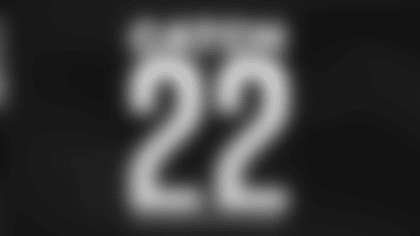After landing second-year QB Drake Maye last offseason, the Patriots want to surround Maye with the best possible supporting cast.
To that end, we could debate whether that means building through the trenches or pairing the second-year quarterback with an elite talent at wide receiver. Although the offensive line and pass-catchers are both critical to building a good offense, high-end wide receivers are one of the most sought-after commodities in the NFL behind only quarterbacks.
Based on Pro Football Focus's wins above replacement metric, skill positions such as wide receiver and cornerback are considered the most impactful positions in pro football besides quarterback, speaking to the value of impacting the passing game. Remarkably, a player in this year's draft can play both receiver and corner at a high level.
From this perspective, the dream draft scenario for the Patriots is that reigning Heisman winner Travis Hunter falls in New England's laps at the fourth-overall pick. Hunter teaming up with Maye to form a formidable QB-WR duo would be ideal. However, as the draft inches closer, it's getting difficult to envision that scenario happening for the Patriots.
At the top of the draft, the Titans seem locked into Miami QB Cam Ward with the number one overall pick. But the Patriots would need the next two picks to be Hunter's college quarterback, Shedeur Sanders, and pass-rusher Abdul Carter to land Hunter. Currently, Hunter makes sense for both the Browns and Giants, who have premier pass-rushers under lucrative multi-year contracts. New York, who controls the Patriots fate with the third-overall pick, already paid edge rusher Brian Burns and drafted Kayvon Thibodeaux fifth-overall in 2022. If he doesn't go in the first two picks, the Giants feel like a Hunter team.
That said, it's not completely out of the question that the Patriots could land Hunter, who we'd have major in wide receiver rather than corner. The 21-year-old is a terrific cornerback prospect, but he's a blue-chip talent and the best wide receiver prospect in this year's class. Hunter's play speed and ball skills make him a natural playmaker who generated an FBS-best 21 plays over 20-plus yards last season. He also ranked in the 93rd percentile in receiving grade and the 70th percentile in separation rate vs. single coverage – an elite offensive weapon.
With the Pats defense in good shape following free agency, there's so much value in Hunter catching passes from Maye as his future WR1. New England added Stefon Diggs to give them some cache in the receiver room. Hunter would also make an immediate impact while giving the Patriots a young tandem on rookie contracts with Maye and Hunter.
Let's break down Hunter's tape at wide receiver and cornerback to discuss the dream scenario of him being drafted by the Patriots.
Wide Receiver
Besides the reasons already mentioned, my preference for playing Hunter primarily on offense comes down to a simple would you rather debate.
Would you rather Hunter have the ball in his hands 8-10 times a game where his game-breaking speed can create explosive plays or hope that he picks off a pass to get the ball in his hands on defense? Although elite corners erasing receivers in coverage have value, the most interceptions any corner had last year was six. In other words, Hunter would have roughly six chances to touch the football per season on defense versus the 96 receptions he had at Colorado last season. To me, that's a no-brainer in favor of Hunter playing offense.
As a wide receiver, Hunter is at his best on in-breaking routes (crossers, slants, digs) where he can break away from coverage and use his elite acceleration to gain yards after the catch. He also ranked second in the class in deep receptions (14), with four touchdowns on go routes, so Hunter can win on the vertical plane in isolation as an outside receiver.
During his bowl game last season, Hunter got loose against the BYU defense for a signature catch-and-run where he gained 58 yards. Colorado liked this double post-cross concept with Hunter running the crosser as the backside receiver. By clearing out one side of the field for Hunter, he can take off into the open space on crossers. He runs a shallow crosser above, accelerating to over 20 MPH in 4.3 seconds, per Reel Analytics.
The reigning Heisman winner has a great feel for finding voids in zone coverages working between the numbers, showing off his nuance as a route runner. Above, the defense falls into a split-safety structure, and the underneath coverage is pulled to the quarterback's right. Hunter works across the field into the open space, staying level throughout the route, catching the ball away from his body and in-stride, and accelerates to daylight. When receivers run through the gauntlet drill at the combine, NFL teams are looking for reps like that one from Hunter.
Hunter's receiving grade vs. zone coverage ranked in the 92nd percentile, which is outstanding. But his blend of play speed and excellent ball skills shine vs. man coverage. Despite being a shade over six feet, 188 pounds, Hunter caught 11 of his 17 contested targets for a contested catch rate of 64.7%. His strong hands and body control to make catches through contact are exciting traits when projecting his ceiling as an NFL receiver.
In this clip, Colorado is running the same double-post cross concept. Hunter sees man coverage this time, so he runs away from man-to-man rather than settling into an open area. With the corner driving the catch point from out of phase, Hunter elevates with incredibly strong hands to pluck the ball over the defender, showing off his rare ball skills.
Next, Hunter runs by single coverage on the outside at the top of the screen. He can stack the corner vs. press-man, adjust back to the under-thrown ball, and make the catch through contact while drawing a flag for pass interference on the play. The body control, concentration, and strength at the catch point here are ridiculous.
From there, Hunter's ability to threaten corners with his vertical stems opens up opportunities for completions on hitches or comebackers. In all, Hunter caught 24 passes on hitch routes, the most of any route he ran in 2024. Above, Hunter flashes impressive route detail by changing speeds within the route to get the corner to commit his hips upfield. First, he slow-plays the route off the line and gears down with low pads and a good burst to get the corner to bite before snapping off the hitch to create separation and immediately turning upfield for YAC.
Lastly, we cannot properly break down Hunter's game without mentioning his red-zone prowess. Hunter is a proven red zone threat as one of Sanders's go-to targets near the end zone, accumulating 15 receiving touchdowns last season (second in the FBS). Once again, his release quickness and knack for making himself quarterback-friendly were apparent, with him shaking corners on goal-line slants and fades.
From a scouting perspective, Hunter has elite movement skills for sudden bursts of speed and changes of direction to go along with excellent body control and hands. Statistically, his 96 catches for 1,258 yards and 15 touchdowns show how dominant he can be as a wide receiver.
Cornerback
Although my preference would be to play Hunter at wide receiver, it's easy to see why so many pundits marvel at his abilities as a cornerback.
The Colorado product's movement skills translate to him being able to match receivers in man coverage at all three levels, while he has above-average length and exceptional ball-hawking instincts to make plays at the catch point. Hunter can play any coverage technique, including press-man, but he's at his best when his eyes are in the backfield in off-man, bail technique, or spot–drop zone.
For example, Hunter's click-and-close as a spot-drop zone defender is absolutely incredible. In this clip, he's playing the flat in cover two. The idea is to read this high-to-low for as long as possible and then drive on the underneath route once the quarterback declares. Hunter does just that, and when the quarterback commits to throwing the flat, he makes one of the interceptions of the year by closing in an instant to make the diving grab.
Hunter can also use his length and ball skills to high-point the ball downfield. Above, he plays a bail technique where he starts on the line of scrimmage. He then drops off the line just before the snap to catch the receiver further downfield, gets in phase, and elevates above the rim to swat the pass away on the jump-ball attempt.
When he does play man coverage closer to the line of scrimmage, Hunter is at his best playing soft press, where he can mirror-and-match receivers by running the routes for them. This is where you see Hunter's receiver background. He has great route anticipation and often breaks for the receiver because he knows how to run routes from their perspective.
Ultimately, Hunter makes more sense for the Patriots if he plays on offense. However, if you prefer him as a cornerback, there aren't any wrong answers here.
Bottom Line
Although it might just be a vocal minority, some pundits question whether or not Hunter is a polished wide receiver after playing both ways in college.
The short rebuttal is that he was learning two positions at once, unlike any other prospect in recent memory. If he's allowed to focus primarily on one side of the ball, the details, such as route running, will improve for Hunter given his exceptional athleticism. The lengthy rebuttal is a little exercise we'll do with an old draft profile from Lance Zeirlien on NFL.com. For context, this was Zeirlien on a recent top-10 pick at the wide receiver position:
"Despite a lack of polish and precision as a route-runner, [blanks]' gliding movements and speed alterations seem to disguise the top-end speed and separation potential that await opposing coverages. He's a bouncy leaper with the athletic ability to make the impossible catches possible," Zeirlien wrote. "He can play all three receiver spots and has the profile to become a productive, high-volume target over all three levels as a potential WR1."
From this perspective, the pros and cons of this mystery prospect sound like Hunter. Now, for the reveal: the mystery player is Giants star WR Malik Nabers. The bottom line is that some athletes are just built differently. Although others might need technical savvy to win, Hunter, like Nabers, is a gifted athlete, making him a natural separator and big-play machine. Plus, changing gears to separate vs. man coverage, finding soft spots in zone coverage, and having high-end ball skills are examples of great nuance at the position. Hunter is a very savvy receiver and a special talent in those veins.
The more common pro comparisons for Hunter at wide receiver are Garrett Wilson, DeVonta Smith, or a ceiling comparison to Justin Jefferson (note: Zeirlien's comp for Nabers was Jefferson). As a corner, his all-around coverage ability while being an excellent ballhawk draws comparisons to Hall of Famer Champ Bailey, who also played both ways in college.
Overall, whichever team drafts Hunter will be getting one of the most exciting non-quarterback prospects to enter the NFL in years.
DISCLAIMER: The views and thoughts expressed in this article are those of the writer and don't necessarily reflect those of the organization. Read Full Disclaimer
































